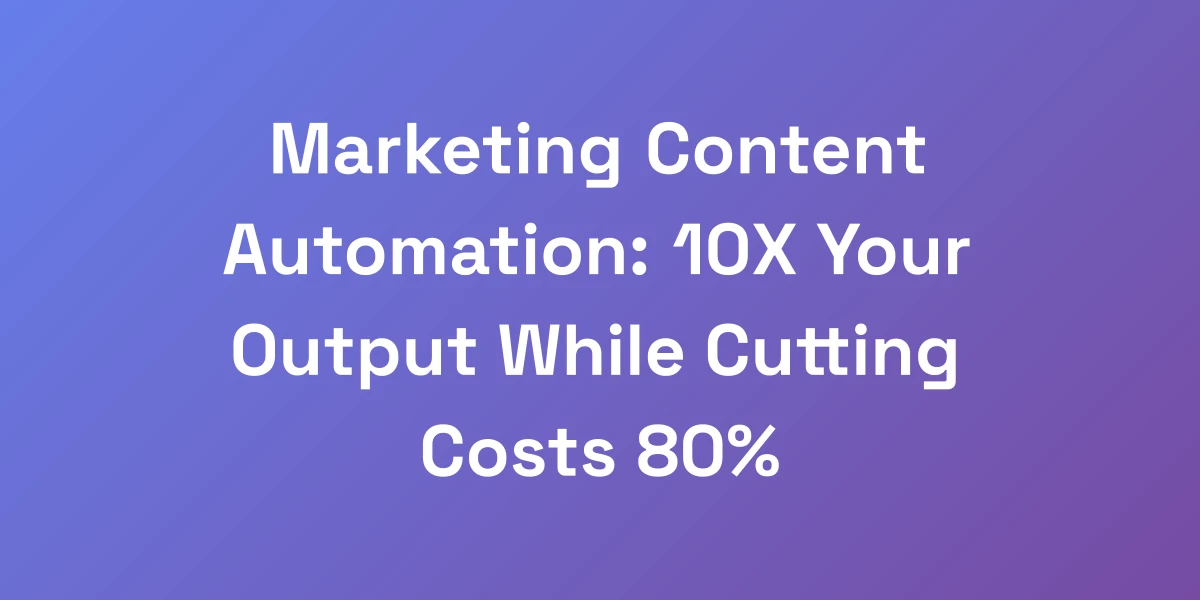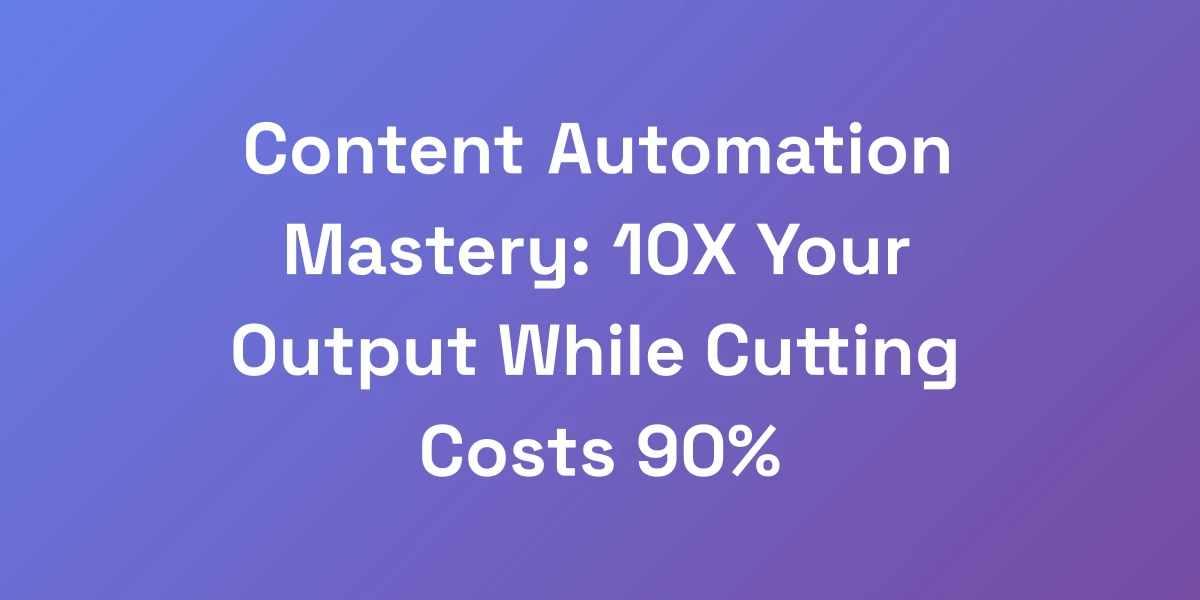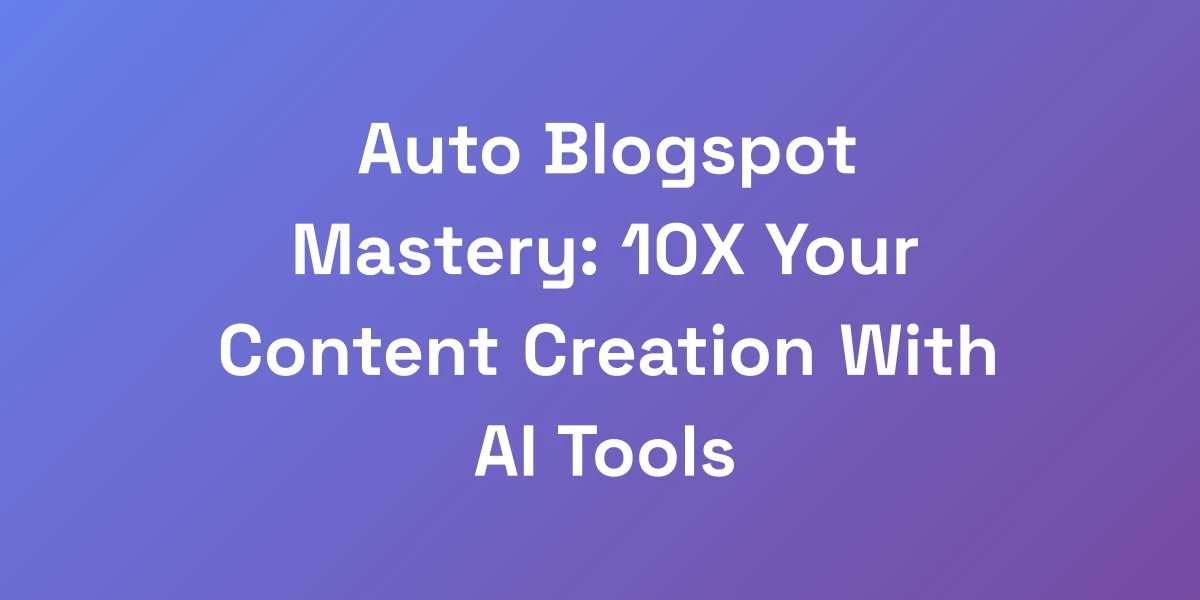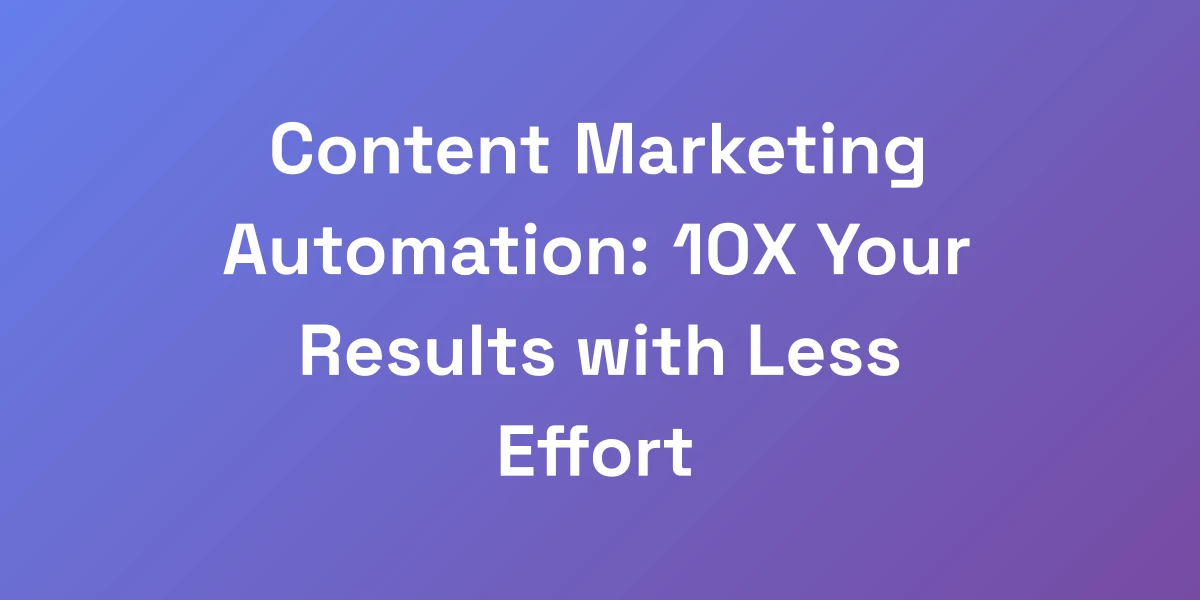
Content Creation Automation: 10X Your Output with AI in 2025
Mar 27, 2025 | By [email protected]
The New Era of Content Creation: Why Traditional Methods Are Dead
Let me be direct – if you’re still creating content the old way, you’re leaving money on the table. Content creation automation isn’t just a trend, it’s the difference between scaling to 7-figures and staying stuck in the content hamster wheel. We’ve seen firsthand how leveraging AI and automation can transform your content strategy, driving conversions like never before.
Imagine doubling, even tripling your content output without sacrificing quality. Sounds impossible? It’s not. The game has changed, and those who adapt first will win big. But why are so many businesses struggling to keep up? Let’s break it down.
The Hidden Cost of Manual Content Creation
Manual content creation isn’t just time-consuming; it’s expensive. Think about the hours your team spends brainstorming, drafting, editing, and publishing. Each hour costs money, and those costs add up quickly.
- Time is Money: The longer it takes to produce content, the more you’re paying for each piece.
- Opportunity Cost: While you’re stuck creating, competitors are scaling.
- Inconsistent Quality: Human error can lead to inconsistencies, hurting your brand’s credibility.
Automation eliminates these hidden costs, allowing you to reinvest resources into what truly matters – growing your business.
Why 90% of Businesses Are Falling Behind
Despite the clear benefits, a staggering 90% of businesses are still lagging in content automation. Why? It’s not a lack of technology; it’s a lack of understanding.
- Resistance to Change: Many companies are comfortable with their current processes, even if they’re inefficient.
- Misconceptions about AI: There’s a fear that automation will replace human jobs, but it’s about augmentation, not replacement.
- Lack of Expertise: Implementing AI requires knowledge and strategy, which many businesses don’t possess.
Those who overcome these barriers are the ones reaping the rewards of content automation.
The Automation Advantage: Real Numbers and ROI
Numbers don’t lie. Businesses that adopt content automation see significant returns on investment as highlighted in the latest global AI-powered content creation market report.
- Increase in Content Output: Companies report up to a 50% increase in content production.
- Cost Reduction: Automation can cut content creation costs by up to 40%.
- Enhanced ROI: With higher output and lower costs, the return on investment skyrockets.
These figures aren’t just impressive – they’re game-changing.
Breaking the Time-Money Trade-off
Traditionally, higher content output meant higher costs and longer production times. But with automation, we break this trade-off.
- Speed: AI automated content creation can generate content in minutes that would take humans hours.
- Scalability: Easily scale your content efforts without a corresponding increase in budget.
- Consistency: Automated systems maintain a consistent quality and tone across all content pieces.
By eliminating the time-money trade-off, you can focus on strategic growth rather than endless content creation.
The Psychology Behind Automated Content Success
Why does automated content work? It taps into the psychology of your audience.
- Personalization: AI can analyze data to tailor content to individual preferences, increasing engagement.
- Timeliness: Automated systems can publish content at optimal times when your audience is most active.
- Consistency: Regular, high-quality content builds trust and authority in your niche.
Understanding these psychological triggers is key to maximizing the effectiveness of your automated content strategy, especially in scenarios like AI content overload in 2024, which has put consumer trust to the test.
Building Your Content Automation Engine
Here’s the truth about content automation that nobody tells you: it’s not about replacing humans, it’s about amplifying their capabilities. We’ve spent years testing different automation systems, and we’ve cracked the code on what actually works. The key is building what we call a Content Multiplication System – a framework that takes one piece of content and turns it into 20 without losing quality.
Ready to build your engine? Let’s dive in.
The Content Multiplication Framework
At the heart of our system lies the Content Multiplication Framework. It’s designed to maximize every piece of content you create by repurposing and optimizing it across multiple channels.
- Core Content Creation: Start with a high-quality piece of content, like a blog post or video.
- Repurposing: Break down the core content into smaller pieces – social media posts, infographics, emails, etc.
- Optimization: Use AI content creation tools to tailor each piece for its specific platform and audience.
- Distribution: Automate the publishing and sharing process across your chosen channels.
This framework ensures that every piece of content serves multiple purposes, maximizing your reach and impact.
Essential Tech Stack for Maximum Output
Building an effective automation engine requires the right tools. Here’s our essential tech stack:
- AI Writing Tools: Platforms like Jasper or AI Writer by WordLift generate high-quality articles and content drafts.
- Content Management Systems (CMS): Tools like WordPress or Contentful for organizing and managing your content.
- Automation Platforms: Tools like Zapier or Integromat to automate workflows between different apps.
- Analytics Tools: Platforms like Google Analytics and HubSpot for tracking content performance.
Choosing the right tools is crucial for creating a seamless and efficient content automation process.
Setting Up Your AI Content Pipeline
Creating an AI-driven content pipeline involves several steps. Here’s how we do it:
- Define Your Content Goals: Understand what you want to achieve – more leads, higher engagement, etc.
- Select Your AI Tools: Choose the tools that align with your goals and integrate well with your existing systems.
- Develop Content Templates: Create templates that guide the AI in producing consistent and high-quality content.
- Automate Workflows: Use automation platforms to connect your tools and streamline the content creation process.
- Test and Iterate: Continuously test your pipeline and make adjustments to improve efficiency and output quality.
Setting up an effective pipeline is the foundation of a successful content automation engine.
Quality Control Checkpoints
Automation doesn’t mean leaving quality to chance. Implement these quality control checkpoints:
- Initial Review: Have your team review the first few pieces of AI-generated content to ensure quality.
- Automated Editing: Use AI tools like Grammarly to automatically check for grammar and style issues.
- Feedback Loops: Continuously gather feedback from your audience to refine and improve content quality.
Ensuring high quality is non-negotiable for maintaining your brand’s reputation and effectiveness.
Scaling Triggers and When to Expand
Knowing when to scale your content automation is crucial. Here are the triggers we watch for:
- Consistent Performance: When your content consistently meets key performance indicators (KPIs).
- Demand Growth: When there’s a clear increase in demand for your content across channels.
- Resource Availability: When you have the necessary resources to support scaling without compromising quality.
Recognizing these triggers allows you to scale your content operations strategically and sustainably.
Integration with Existing Systems
Seamless integration with your existing systems is key to maximizing efficiency. Here’s how we do it:
- API Connections: Use APIs to connect your AI tools with your CMS and other platforms.
- Data Synchronization: Ensure data flows smoothly between tools to maintain consistency and accuracy.
- Unified Dashboard: Create a centralized dashboard to monitor and manage all aspects of your content automation process.
Integration ensures that your automation engine operates smoothly within your existing workflow.
Advanced AI Tools and Techniques for Content Automation
Listen carefully, because this is where most people mess up. They think throwing an AI tool at their content problems will solve everything. But the real magic happens when you combine multiple AI tools in a strategic sequence. We’ve perfected our AI Content Stack, generating 100+ pieces of high-quality content per week with minimal human oversight.
This isn’t theory – it’s the same system we use in our 8-figure businesses.
The AI Content Stack Revealed
Our AI Content Stack consists of a series of specialized tools working in harmony to automate every step of content creation.
- Content Generation: Using tools like Jasper to create initial drafts based on your guidelines.
- Content Enhancement: Employing Grammarly for grammar and style improvements.
- SEO Optimization: Integrating Surfer SEO to ensure content is optimized for search engines.
- Publishing Automation: Utilizing Zapier to automate the publishing process across multiple platforms.
This stack ensures that from creation to publication, every piece of content is optimized and ready to perform.
Tool Integration and Workflow Design
Strategic integration of tools is essential for maximizing efficiency. Here’s our approach:
- Sequential Automation: Each tool performs a specific task in the content creation process.
- Trigger-Based Actions: Certain actions trigger subsequent steps automatically.
- Feedback Loops: Continuous feedback ensures that each tool is performing optimally and improving over time.
Designing workflows that smartly integrate these tools ensures a seamless and highly efficient content creation process.
Prompt Engineering Mastery
Effective prompt engineering is the key to getting the most out of your AI tools. Here’s how we master it:
- Clear Instructions: Providing specific and concise prompts to guide content generation.
- Contextual Prompts: Including relevant context to ensure the AI understands the desired tone and style.
- Iterative Refinement: Continuously refining prompts based on performance and feedback.
Mastering prompt engineering allows you to produce high-quality, relevant content consistently.
Content Repurposing Automation
Repurposing content is a powerful way to maximize your efforts. Here’s how we automate it:
- Multi-Format Conversion: Automatically convert blog posts into videos, infographics, and social media posts.
- Content Syndication: Distribute your content across various platforms to reach a wider audience.
- Automated Updates: Keep your content fresh by automating updates based on the latest data and trends.
Automating content repurposing ensures that your core content serves multiple purposes, increasing its value and reach.
Performance Tracking and Optimization
Tracking performance is crucial for continuous improvement. Here’s how we do it:
- Real-Time Analytics: Monitor content performance in real-time using tools like Google Analytics.
- Automated Reporting: Generate detailed reports automatically to assess performance against KPIs.
- Optimization Algorithms: Use automation algorithms to analyze data and suggest optimizations for future content.
These KPIs provide a comprehensive view of your content’s performance and its impact on your business goals.
Future-Proofing Your Stack
The digital landscape is always evolving. Here’s how we ensure your AI Content Stack stays ahead:
- Continuous Learning: Regularly update your tools and strategies based on the latest AI advancements.
- Scalable Infrastructure: Use scalable tools that can grow with your content needs.
- Flexibility: Adapt your stack to incorporate new tools and technologies as they emerge, and stay compliant with the latest regulations in the artificial intelligence legislation snapshot.
Future-proofing your stack ensures that your content automation engine remains efficient and effective in the long term.
Maintaining Human Touch in Automated Content
Here’s the million-dollar secret: automation without personality is worthless. We’ve seen countless businesses fail because they forgot this fundamental truth. The goal isn’t to remove humanity from your content – it’s to amplify it. Here’s how we inject our unique voice and personality into every piece of automated content, ensuring it connects with your audience on a deeper level while maintaining scale.
Let’s explore how to keep your content human-centric even in an automated environment.
Voice and Tone Preservation
Maintaining a consistent voice and tone is crucial. Here’s how we do it:
- Style Guides: Develop detailed style guides that define your brand’s voice and tone.
- AI Training: Train your AI tools on past content to ensure they mimic your style accurately.
- Regular Audits: Periodically review automated content to ensure it aligns with your brand’s voice.
Consistent voice and tone help in building a strong brand identity and fostering trust with your audience.
Emotional Trigger Integration
Emotions drive engagement. Here’s how we integrate emotional triggers into automated content:
- Data-Driven Insights: Use audience data to understand the emotional triggers that resonate most.
- AI Sentiment Analysis: Implement AI tools that analyze and incorporate the right emotional tones into your content.
- Storytelling Elements: Embed storytelling techniques that evoke emotions and connect with your audience.
Emotionally resonant content fosters deeper connections and higher engagement rates.
Personalization at Scale
Personalization is key to making content relevant. Here’s how we achieve it:
- User Data Utilization: Leverage user data to tailor content to individual preferences and behaviors.
- Dynamic Content: Use AI to create dynamic content that changes based on user interactions.
- Segmented Campaigns: Automate content distribution to specific segments of your audience for maximum relevance.
Personalized content ensures that each piece speaks directly to its intended audience, enhancing engagement and conversions.
Brand Story Automation
Your brand story is your unique value proposition. Here’s how we automate it:
- Narrative Templates: Create narrative templates that encapsulate your brand story and values.
- Consistent Messaging: Ensure all automated content aligns with your core brand story.
- Automated Story Updates: Keep your brand story evolving with AI-driven updates based on new developments and insights.
Automating your brand story ensures consistency and reinforces your brand identity across all content channels.
Quality Assurance Systems
Quality assurance is non-negotiable. Here’s how we maintain it:
- Automated Proofreading: Use AI tools to automatically check for errors and inconsistencies.
- Regular Reviews: Implement regular content reviews to ensure standards are met.
- Feedback Integration: Continuously gather and integrate feedback to improve content quality.
Robust quality assurance systems ensure that your automated content maintains high standards and supports your brand’s reputation.
Human Review Protocols
Human oversight is essential for maintaining quality and relevance. Here’s our approach:
- Final Approval: Have designated team members review and approve all automated content before publication.
- Spot Checks: Conduct random spot checks to ensure ongoing quality and alignment with brand standards.
- Continuous Training: Train your team to work alongside AI, understanding its strengths and limitations.
Human review protocols ensure that your content remains accurate, relevant, and aligned with your brand’s voice and goals.
Measuring and Scaling Your Automated Content System
Let’s talk numbers, because that’s what really matters. If you can’t measure it, you can’t improve it. We’ve developed a specific set of metrics that tell you exactly when to scale up your content automation and when to pull back. This isn’t about vanity metrics – it’s about tracking the numbers that directly correlate with revenue growth. Here’s how we do it:
Understanding these metrics allows you to make data-driven decisions that enhance your content strategy.
Key Performance Indicators
Tracking the right KPIs is essential. Here are the key ones we focus on:
- Engagement Rates: Measures how users interact with your content (likes, shares, comments).
- Conversion Rates: Tracks how content leads to desired actions, such as purchases or sign-ups.
- Traffic Metrics: Monitors the amount of traffic generated by your content across different channels.
- SEO Performance: Evaluates how well your content ranks in search engine results.
These KPIs provide a comprehensive view of your content’s performance and its impact on your business goals.
Scaling Triggers and Thresholds
Knowing when to scale your content efforts is crucial. Here are the triggers we watch for:
- Consistent KPI Achievement: When KPIs consistently meet or exceed targets.
- Increased Demand: When there’s a noticeable increase in demand for your content.
- Resource Readiness: When you have the infrastructure and resources to support scaling.
Recognizing these triggers ensures that you scale strategically, maintaining quality and effectiveness.
ROI Calculation Framework
Calculating ROI is essential to justify content automation investments. Here’s our framework:
- Cost Savings: Calculate the reduction in costs from automation compared to manual processes.
- Revenue Increase: Measure the revenue increase generated directly from your automated content efforts.
- Efficiency Gains: Quantify the time saved and how it translates into additional productivity.
This framework helps you understand the financial impact of your content automation efforts and make informed decisions.
Content Performance Analytics
Deep dive into analytics to understand your content’s performance. Here’s how:
- Detailed Reports: Use business intelligence tools like Google Analytics and HubSpot to generate detailed performance reports.
- Trend Analysis: Analyze trends over time to identify what’s working and what’s not.
- A/B Testing: Conduct A/B tests to optimize different aspects of your content strategy.
Comprehensive analytics provide the insights needed to continuously improve your content automation system.
Optimization Protocols
Continuous optimization is key to maintaining effectiveness. Here’s our approach:
- Regular Reviews: Schedule periodic reviews of your content strategy based on performance data.
- Feedback Implementation: Integrate feedback from your audience and team to refine your content.
- Algorithm Adjustments: Adjust AI algorithms based on the latest performance insights and trends.
Optimization protocols ensure that your content remains relevant and effective in driving your business goals.
Growth Forecasting Models
Predict future growth with accurate forecasting models. Here’s how we do it:
- Historical Data Analysis: Use historical performance data to predict future trends.
- Predictive Analytics: Implement predictive analytics tools to forecast content performance and ROI.
- Scenario Planning: Develop different growth scenarios based on various content strategies and market conditions.
Growth forecasting models help you plan and allocate resources effectively, ensuring sustained growth and success.
Conclusion
We’ve journeyed through the transformative power of content creation automation, uncovering how AI can multiply your output tenfold by 2025. From cutting hidden costs and breaking the time-money trade-off to building a robust automation engine and maintaining that crucial human touch – the path is clear.
Remember, content automation isn’t about replacing your team, it’s about empowering them. By embracing advanced AI tools and strategic frameworks, we can scale efficiently while delivering authentic, engaging content that resonates with our audience.
Now, it’s your turn to take the leap. Start integrating these strategies, optimize your workflows, and watch your content output soar. Let’s 10X your content creation and achieve unprecedented growth together.
What’s holding you back from automating your content strategy? Share your thoughts and experiences below – let’s continue the conversation!
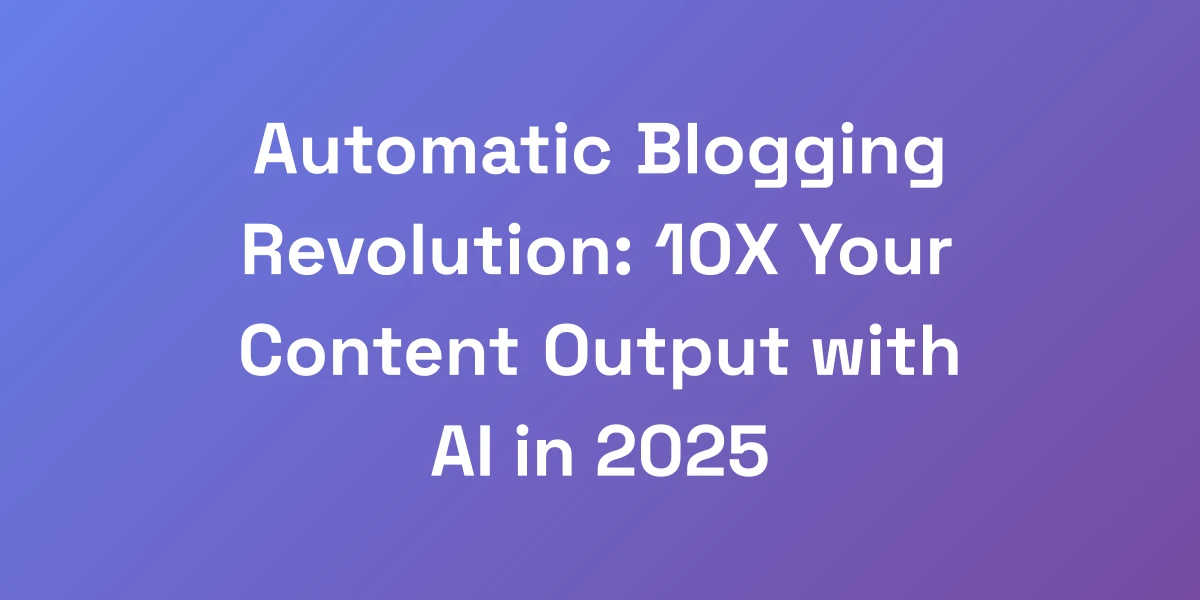
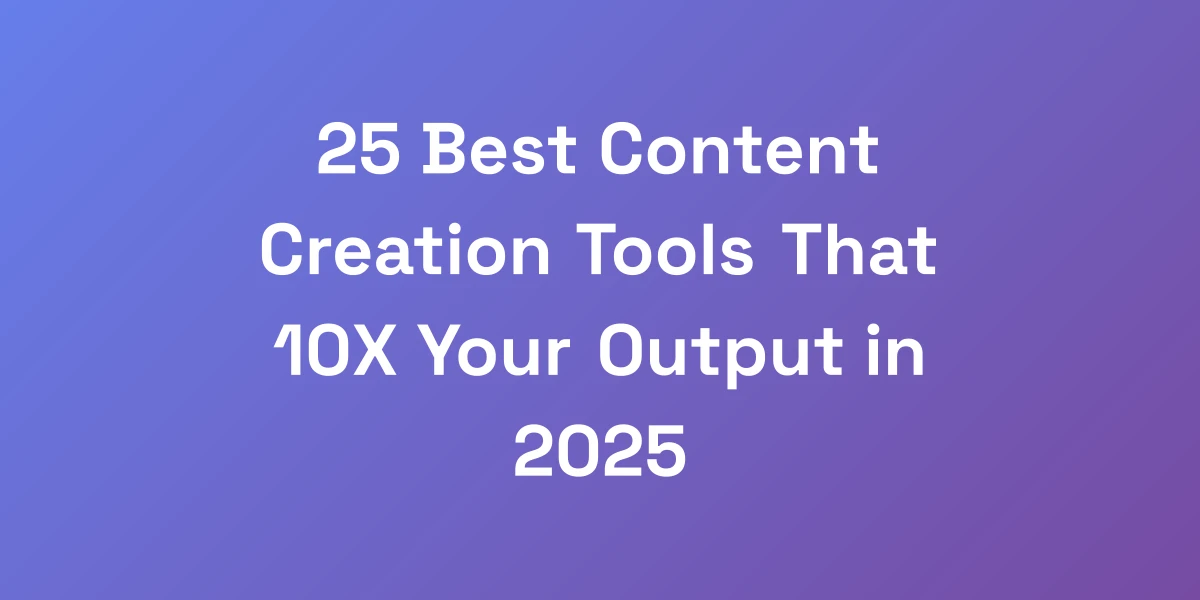
![21 Best Content Creation Software Tools That 10X Your Output [2025]](https://autoseo.eazyseo.co/wp-content/uploads/2025/04/21-Best-Content-Creation-Software-Tools-That-10X-Y.webp)
